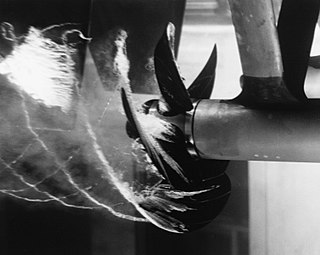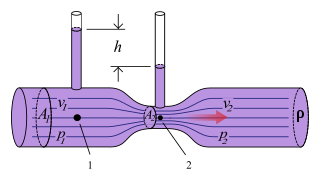
Cavitation is a phenomenon in which rapid changes of pressure in a liquid lead to the formation of small vapor-filled cavities, in places where the pressure is relatively low.

In physics and engineering, fluid dynamics is a subdiscipline of fluid mechanics that describes the flow of fluids—liquids and gases. It has several subdisciplines, including aerodynamics and hydrodynamics. Fluid dynamics has a wide range of applications, including calculating forces and moments on aircraft, determining the mass flow rate of petroleum through pipelines, predicting weather patterns, understanding nebulae in interstellar space and modelling fission weapon detonation.

In fluid dynamics, the Mach number is a dimensionless quantity representing the ratio of flow velocity past a boundary to the local speed of sound.
Flow measurement is the quantification of bulk fluid movement. Flow can be measured in a variety of ways. The common types of flowmeters with industrial applications are listed below:

The Venturi effect is the reduction in fluid pressure that results when a fluid flows through a constricted section of a pipe. The Venturi effect is named after its discoverer, Giovanni Battista Venturi.
A gas meter is a specialized flow meter, used to measure the volume of fuel gases such as natural gas and liquefied petroleum gas. Gas meters are used at residential, commercial, and industrial buildings that consume fuel gas supplied by a gas utility. Gases are more difficult to measure than liquids, because measured volumes are highly affected by temperature and pressure. Gas meters measure a defined volume, regardless of the pressurized quantity or quality of the gas flowing through the meter. Temperature, pressure, and heating value compensation must be made to measure actual amount and value of gas moving through a meter.
An orifice plate is a device used for measuring flow rate, for reducing pressure or for restricting flow.
Choked flow is a compressible flow effect. The parameter that becomes "choked" or "limited" is the fluid velocity.
A wet gas is any gas with a small amount of liquid present. The term "wet gas" has been used to describe a range of conditions varying from a humid gas which is gas saturated with liquid vapour to a multiphase flow with a 90% volume of gas. There has been some debate as to its actual definition but there is currently no fully defined quantitative definition of a wet gas flow that is universally accepted.

A thermal expansion valve or thermostatic expansion valve is a component in refrigeration and air conditioning systems that controls the amount of refrigerant released into the evaporator thereby keeping superheat, that is, the difference between the current refrigerant temperature at the evaporator outlet and its saturation temperature at the current pressure, at a stable value, ensuring that the only phase in which the refrigerant leaves the evaporator is vapor, and, at the same time, supplying the evaporator's coils with the optimal amount of liquid refrigerant to achieve the optimal heat exchange rate allowed by that evaporator. In addition, some thermal expansion valves are also specifically designed to ensure that a certain minimum flow of refrigerant can always flow through the system. Thermal expansion valves are often referred to generically as "metering devices" although this may also refer to any other device that releases liquid refrigerant into the low-pressure section but does not react to temperature such as a capillary tube or a pressure-controlled valve.
The term separator in oilfield terminology designates a pressure vessel used for separating well fluids produced from oil and gas wells into gaseous and liquid components. A separator for petroleum production is a large vessel designed to separate production fluids into their constituent components of oil, gas and water. A separating vessel may be referred to in the following ways: Oil and gas separator, Separator, Stage separator, Trap, Knockout vessel, Flash chamber, Expansion separator or expansion vessel, Scrubber, Filter. These separating vessels are normally used on a producing lease or platform near the wellhead, manifold, or tank battery to separate fluids produced from oil and gas wells into oil and gas or liquid and gas. An oil and gas separator generally includes the following essential components and features:
A flow computer is an electronic computer which implements algorithms using the analog and digital signals received from flow meters, temperature, pressure and density transmitters to which it is connected into volumes at base conditions. They are used for custody or fiscal transfer.

A positive displacement meter is a type of flow meter that requires fluid to mechanically displace components in the meter in order for flow measurement. Positive displacement (PD) flow meters measure the volumetric flow rate of a moving fluid or gas by dividing the media into fixed, metered volumes. A basic analogy would be holding a bucket below a tap, filling it to a set level, then quickly replacing it with another bucket and timing the rate at which the buckets are filled. With appropriate pressure and temperature compensation, the mass flow rate can be accurately determined.
Custody Transfer in the oil and gas industry refers to the transactions involving transporting physical substance from one operator to another. This includes the transferring of raw and refined petroleum between tanks and tankers; tankers and ships and other transactions. Custody transfer in fluid measurement is defined as a metering point (location) where the fluid is being measured for sale from one party to another. During custody transfer, accuracy is of great importance to both the company delivering the material and the eventual recipient, when transferring a material.
In fluid measurement, the fluid's flow conditions refer to quantities like temperature and static pressure of the metered substance. The flowing conditions are required data in order to calculate the density of the fluid at flowing conditions. The flowing density is in turn required in order to compensate the measured volume to quantity at base conditions.
Instrumentation is used to monitor and control the process plant in the oil, gas and petrochemical industries. Instrumentation comprises sensor elements, signal transmitters, controllers, indicators and alarms, actuated valves, logic circuits and operator interfaces.

A measuring instrument is a device for measuring a physical quantity. In the physical sciences, quality assurance, and engineering, measurement is the activity of obtaining and comparing physical quantities of real-world objects and events. Established standard objects and events are used as units, and the process of measurement gives a number relating the item under study and the referenced unit of measurement. Measuring instruments, and formal test methods which define the instrument's use, are the means by which these relations of numbers are obtained. All measuring instruments are subject to varying degrees of instrument error and measurement uncertainty. These instruments may range from simple objects such as rulers and stopwatches to electron microscopes and particle accelerators. Virtual instrumentation is widely used in the development of modern measuring instruments.
Flow conditioning ensures that the “real world” environment closely resembles the “laboratory” environment for proper performance of inferential flowmeters like orifice, turbine, coriolis, ultrasonic etc.
Capillary flow porometry, also known as porometry, is a characterization technique based on the displacement of a wetting liquid from the sample pores by applying a gas at increasing pressure. It is widely used to measure minimum, maximum and mean flow pore sizes, and pore size distribution of the through pores in membranes nonwovens, paper, filtration and ultrafiltration media, hollow fibers, ceramics, etc.
In the petroleum industry, allocation refers to practices of breaking down measures of quantities of extracted hydrocarbons across various contributing sources. Allocation aids the attribution of ownerships of hydrocarbons as each contributing element to a commingled flow or to a storage of petroleum may have a unique ownership. Contributing sources in this context are typically producing petroleum wells delivering flows of petroleum or flows of natural gas to a commingled flow or storage.